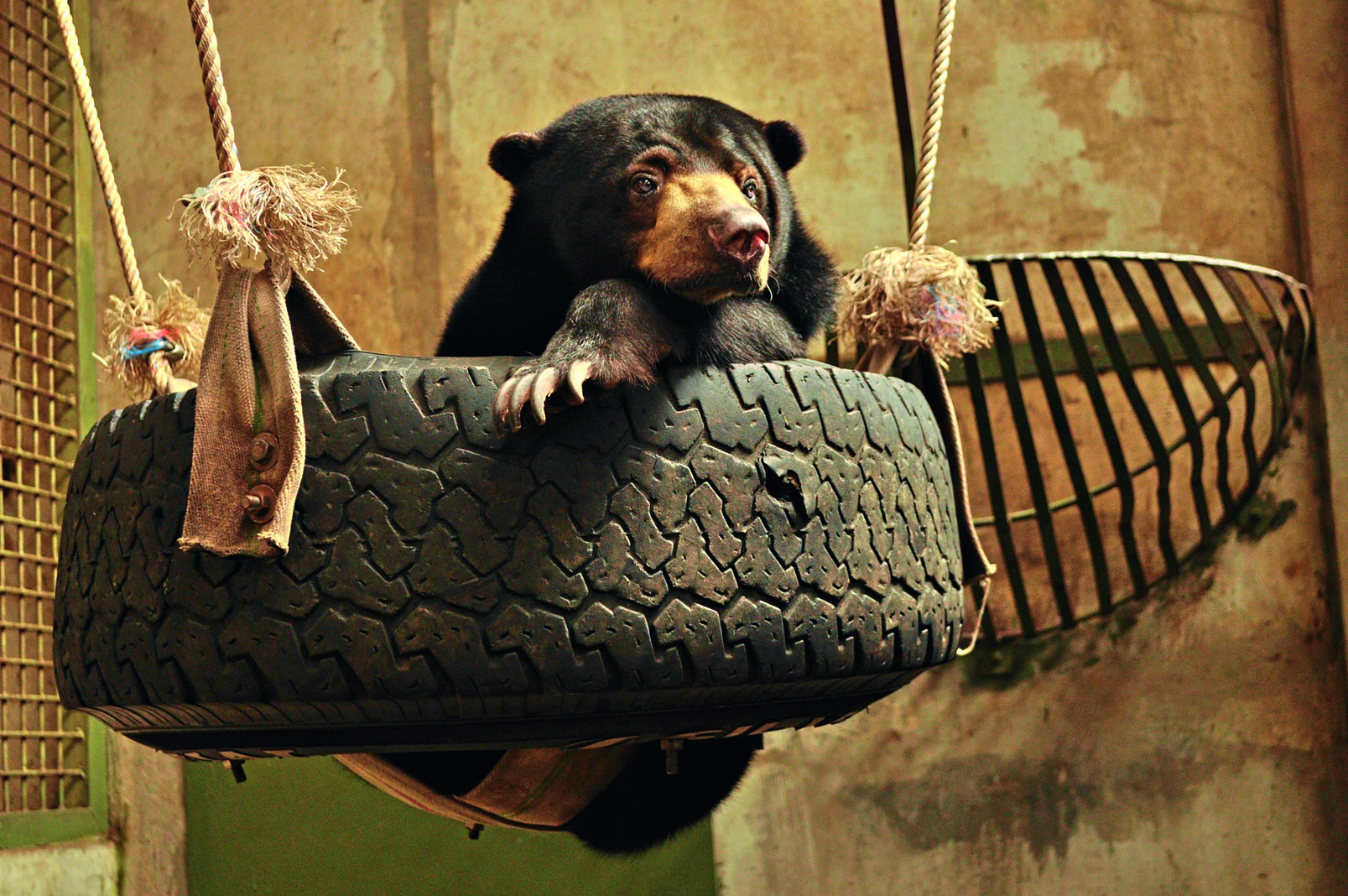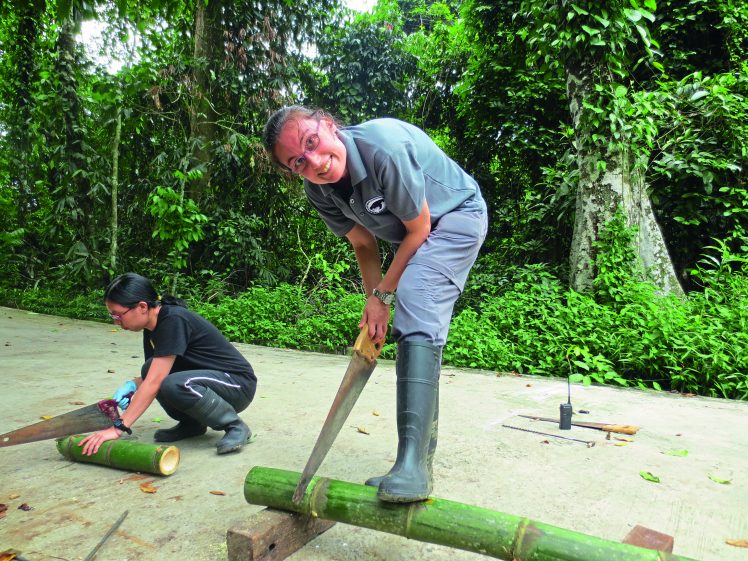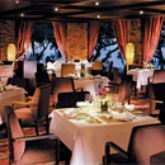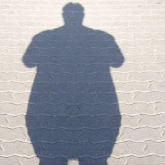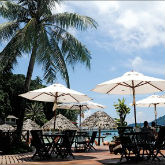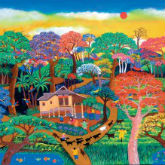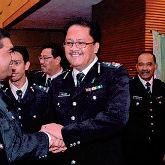
The East Malaysian state of Sabah is a popular tourist destination for wildlife watching, especially since the region is home to some charismatic mammals including orangutans, proboscis monkeys, and pygmy elephants. Yet, very few people realise that the world’s smallest bear species, known as the Bornean Sun Bear, is also resident here.
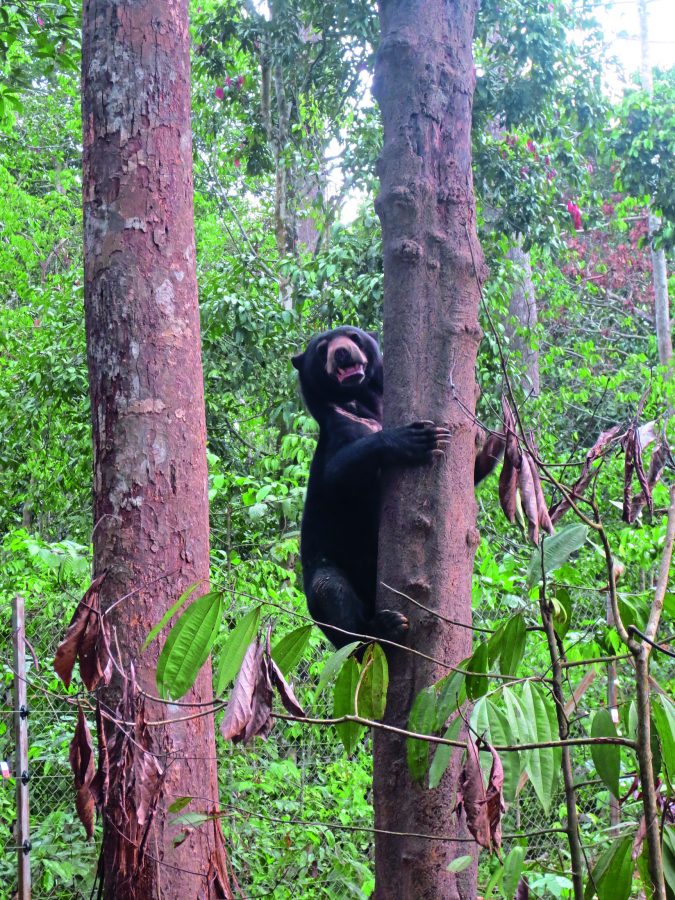 This is not surprising since this solitary and elusive animal spends much of its time climbing up trees to eat, rest, and escape from danger.
This is not surprising since this solitary and elusive animal spends much of its time climbing up trees to eat, rest, and escape from danger.
You would be unlikely to spot one in the wild, since the bear’s dark, usually black fur offers excellent camouflage in the tropical forest and an acute sense of smell quickly alerts it to the presence of humans.
Normally sun bears will avoid people, but the dramatic loss of their forest habitat to logging and palm oil plantations means that they must venture into areas populated by humans in order to find food to survive.
Unfortunately, this leads to conflict with local people who are fearful of these bears and may kill them.
This species is further threatened by poaching to supply bear meat for human consumption and body parts for use in traditional Chinese medicines.
Consequently, sun bear populations in the wild have dramatically declined in recent decades and now this species is classified as “vulnerable to extinction.”
However, their future may now be less uncertain in Sabah where a rescue and rehabilitation facility has recently been established for these bears.
From visitor to volunteer
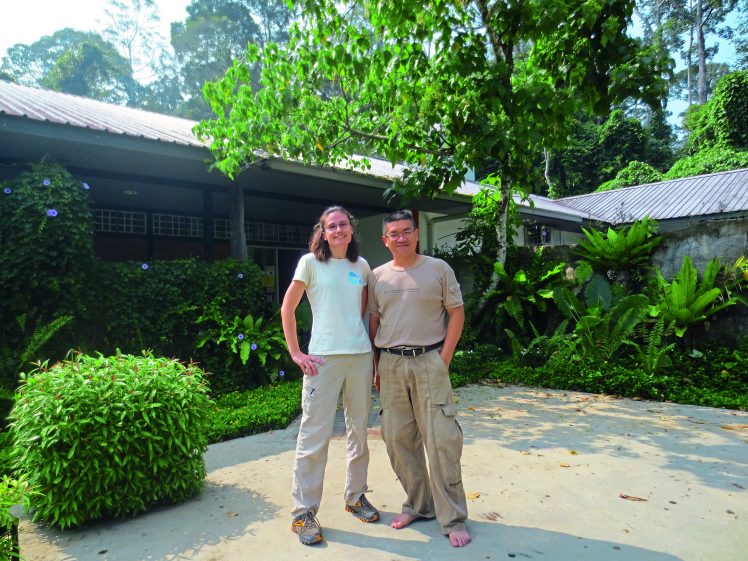
My own interest in sun bears started when I travelled to East Sabah last year and visited the Bornean Sun Bear Conservation Centre (BSBCC) at Sepilok, which is next to the famous Orangutan Rehabilitation Centre. Despite numerous wildlife watching trips throughout Malaysia whilst living in Kuala Lumpur, I had never seen a sun bear until I visited the BSBCC.
This centre was founded in 2008 by sun bear biologistWong Siew Te who made it his mission to rehabilitate and improve the welfare of rescued bears so that some may be returned to the wild. His knowledge enabled the construction of specially designed indoor and outdoor enclosures to meet the physical and behavioural needs of the bears, many of which had been traumatised by their previous captivity.
From the visitor platform, I had a perfect view of one bear using its huge claws to rip apart logs for a feast of termites, guzzling them up using its extraordinarily long tongue. Nearby, another agile bear was rapidly scaling up a tree to reach some high branches whereupon it set about making a comfortable resting area.
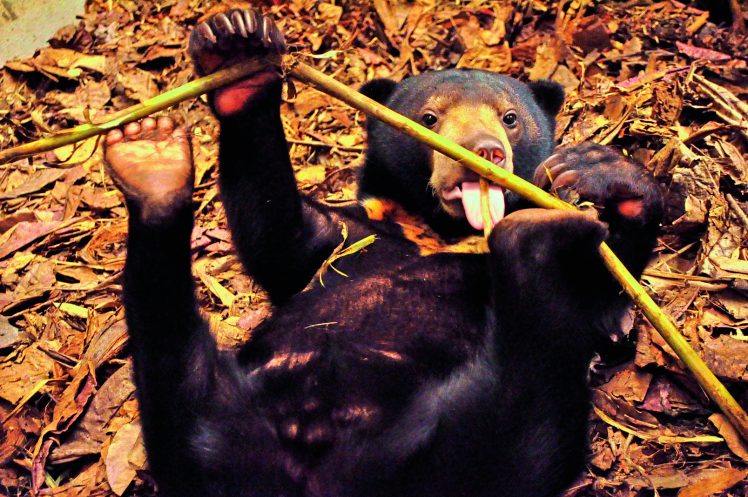
This juvenile bear lazily regarded its audience of humans, who were busy focusing their camera lenses for the best “relaxing bear” shot. During my brief time there, I became captivated by this small bear species. My professional training in veterinary medicine and wildlife conservation led to me to wonder how I could assist the BSBCC in their conservation efforts.
Searching their website soon led me to discover that the centre offered a two- or four-week volunteer programme providing assistance to the keepers in the daily care of the bears. This sounded perfect, so I filled in my online application and was quickly accepted for a September 2015 intake. The whole process was efficiently facilitated by the social enterprise organisation, APE Malaysia.
September 2015 came, and I returned to the BSBCC, this time as a volunteer rather than a tourist. On meeting the enthusiastic APE Malaysia coordinators, Harith and Vicki, who would assist my involvement in the programme, I knew we would get along well due to our shared love of Malaysian food and wildlife!
My first day was spent being introduced to the centre and its staff, particularly the five keepers with whom I would be spending the most time. I soon realised that although the sun bears may look cute, they have formidable claws and sharp canine teeth, so close encounters with them would be best avoided!
Getting to know the bears
I was enthusiastic to start my work at the bear house and meet the 35 animals for myself. The friendly team of keepers told me that they could recognise each of them from their unique U-shaped chest mark and varying facial characteristics. I hoped eventually I would be able to identify some of the individual bears, too.
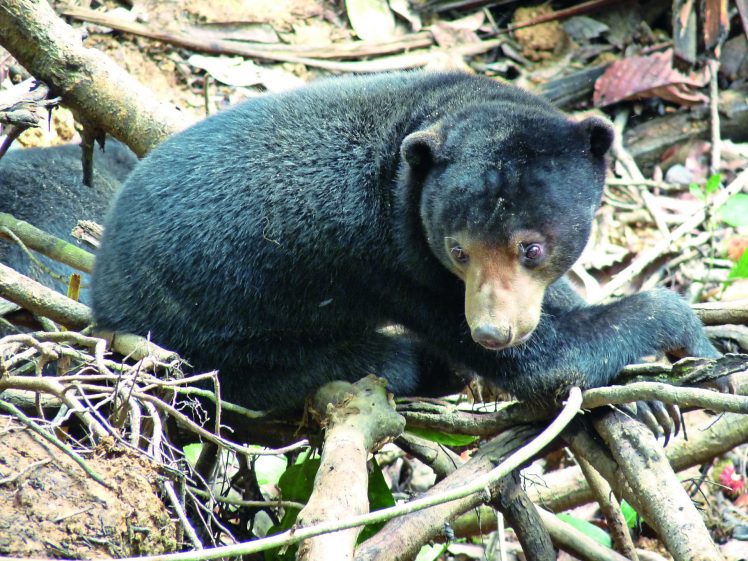
After a few days of observing them in their enclosures, I started to notice their particular personalities and habits. I liked watching the bold, energetic male called Fulung play-fighting with his mates and also seeing how Mary’s inquisitive nature made up for her small, under-developed stature. One of my favourite bears was a large adult male called Linggam, who could often be found relaxing upsidedown in his nesting basket with his limbs stretched out after he had consumed a breakfast of rice porridge.
My involvement in the daily routine of preparing food, feeding the bears and cleaning out the indoor enclosures meant that I had plenty of opportunity to watch their activities. The daily dietary intake of each bear was carefully calculated based upon weight and age, with some individuals having specific dietary requirements related to their health status, as many had suffered malnourishment whilst kept as pets.
The bears greatly enjoyed their twice-daily rice porridge feeding and usually slurped it down in a couple of minutes, licking up every last drop. Their long curved claws and strong forelimbs enabled them to easily scale up the bars to reach the fruit we had thrown on top of the enclosure. I particularly enjoyed walking to the forest enclosures to scatter fruit over the fence for the bears to find amongst the vegetation. Despite their physical strength, they showed surprising dexterity when peeling rambutans or bananas to eat the fruit inside.
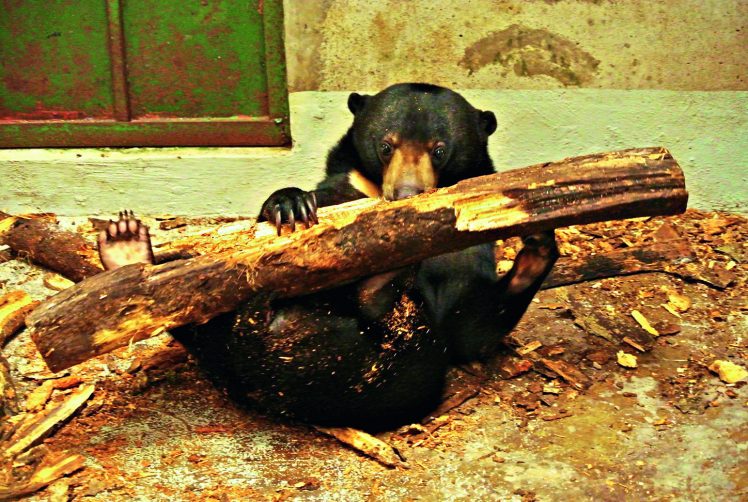
In the wild, sun bears consume a great variety of fruits depending upon the particular fruiting season and eat huge quantities of insects, such as termites, ants, beetles, and larvae. Therefore, the keepers often collected termite nests and logs from the forest to bring to the indoor enclosures, which stimulated the digging and foraging behaviour of the bears.
Of course, they love honey and will raid honeybee nests in trees to get their paws on it. Honey was often a useful bribe for the bears and could be used to persuade them to do things, such as take medicine.
Sun bear feeding activities in the wild actually benefit the forest ecosystem, since they disperse fruit seeds, control termite populations and create nesting sites in trees for other wildlife, thus highlighting the importance of their conservation.
Observations and interactions
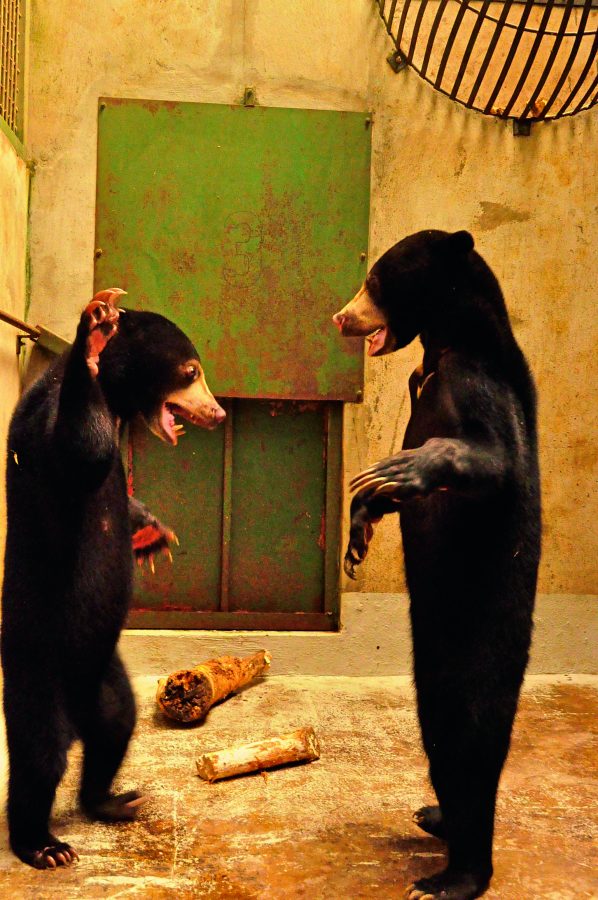
One vital aspect of the rehabilitation process was integrating compatible bears to enable them to live together in small groups. This socialisation allows them to learn skills from each other and go out as a group into the forest enclosures, after their electric fence training.
I learnt all about the complicated nature of bear relationships from Lin May, who has responsibility for bear integration. Sun bears are not always sociable animals and introductions have to be done one by one under careful observation of the staff.
Since I am a veterinary surgeon, I was afforded the privilege of watching the socialisation of some juvenile bears and it was fascinating to see their dynamic interactions.
Fulung rushed though into Montom’s pen to start a vigorous play-fight, involving wrestling, neck biting, and rolling. At one point they stood up on their hind legs to face each other like boxing opponents and clashed their claws together. It looked painful, but Lin May assured me that such enthusiasm was normal for sun bears.
Meanwhile, Mary was more cautious and watched the play-fight from the safe distance of a hammock, she did not want to get involved. A variety of introductions were carried out that day and observations of the behaviour between bears was carefully recorded so that decisions could be made about grouping them.
Another important part of the volunteer programme was making enrichment activities to stimulate the sun bears in their captive environment. Sadly, several bears had developed characteristic pacing and licking behaviours due to their long confinement as pets.
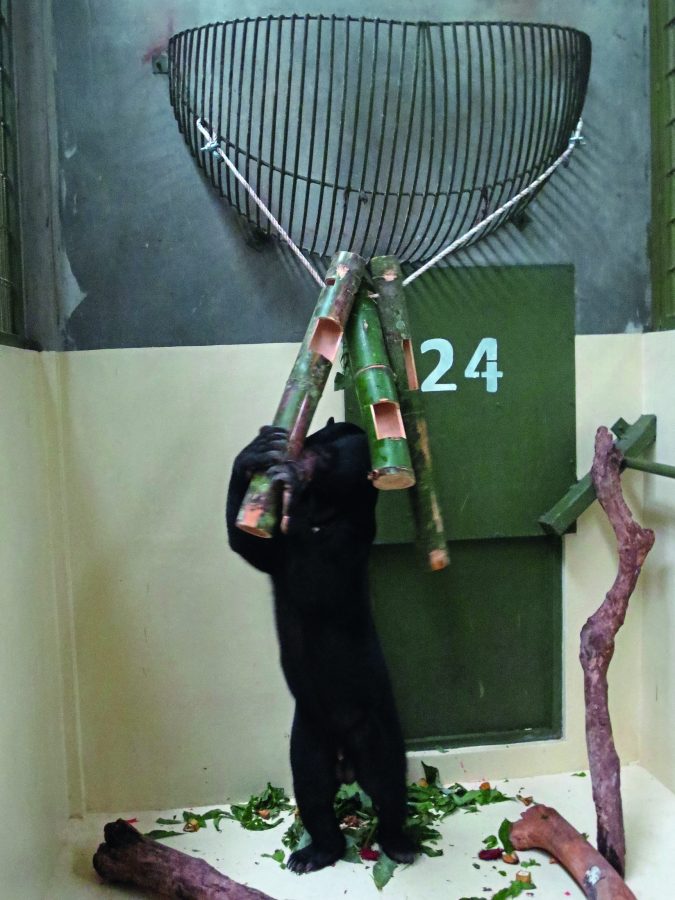 It was important to encourage their natural bear behaviours of foraging, climbing, digging, and chewing. A personal highlight for me was designing and making a hanging bamboo puzzle feeder, which encouraged the bear to climb up and explore the sections of bamboo, which was filled with forest vegetation and chopped banana.
It was important to encourage their natural bear behaviours of foraging, climbing, digging, and chewing. A personal highlight for me was designing and making a hanging bamboo puzzle feeder, which encouraged the bear to climb up and explore the sections of bamboo, which was filled with forest vegetation and chopped banana.
We placed one into Panda’s enclosure (she is definitely not a panda but her previous owner had mistaken her for a small panda rather than a sun bear, so the name stuck!) and within minutes she had gone up to grab some plants to eat and then spent the next 24 hours emptying it all out.
Afterwards, I wrote an enrichment record about the activity so that its design and effectiveness could be assessed.
This enabled Rodger the keeper to construct two more, but he modified the hanging method for Ronnie and Sigalung who then delighted in swinging on the bamboo before breaking it apart to eat the contents.
It was highly satisfying as a volunteer to know that I had contributed to improving the welfare of these bears.
The veterinarian as a carpenter
During my second week, our construction abilities were truly tested in the creation of a wooden resting platform for Montom and Susie. I certainly lacked the practical skills of using a saw, drill, and spanner, much to the amusement of the keepers who knew exactly what to do.
Thankfully, the expertise of the team meant it was built and installed within four days.Would the bears be impressed with our efforts? Once it was in the enclosure, Montom immediately went in to sniff the new object out, as it carried the scent of all the humans who had sweated over its construction. Its stability and strength were tested when he climbed on top of it and walked around.
Within a short time, he started chewing at the wood, even pulling some chunks off, since sun bears also like to investigate things with their mouths.When the keepers checked up on the platform the following morning, one plank had already been completely ripped off! We concluded that some modifications in platform design would be necessary to increase its durability and this event gave me further respect for the strength of these bears.
It is impossible for me to write about all the highlights of my volunteering experience, as there were so many. The busy daily routine meant that my two weeks passed by far too quickly. Overall, I was very impressed with the knowledge, dedication and commitment of the BSBCC staff who welcomed me into their team.
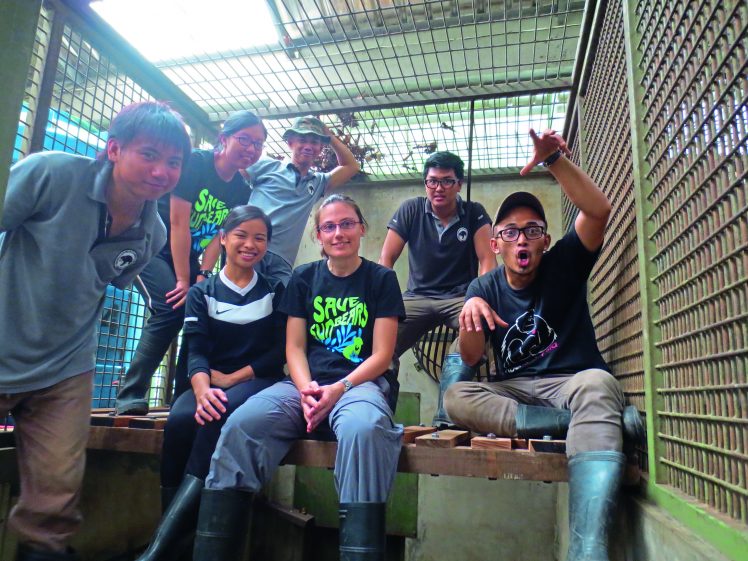
The APE Malaysia facilitators also helped me to understand more about developing enrichment activities and encouraged me to think like a bear when making them. Who knows when my creative use of bamboo may be needed again!
It was fantastic to see how the lives of these captive bears had been dramatically improved by the BSBCC, and I am certain that this well-organised rehabilitation process will give many of these sun bears the opportunity of returning to the wild.
From my work behind the scenes at BSBCC, it is evident that their conservation efforts offer hope for the future of sun bears in Borneo. So why not volunteer to make your own contribution to their work? It’s a great way to leave behind a lasting legacy of your time in Malaysia!
How you can help
Visit the BSBCC website to learn more about their work: bsbcc.org.my
"ExpatGo welcomes and encourages comments, input, and divergent opinions. However, we kindly request that you use suitable language in your comments, and refrain from any sort of personal attack, hate speech, or disparaging rhetoric. Comments not in line with this are subject to removal from the site. "

